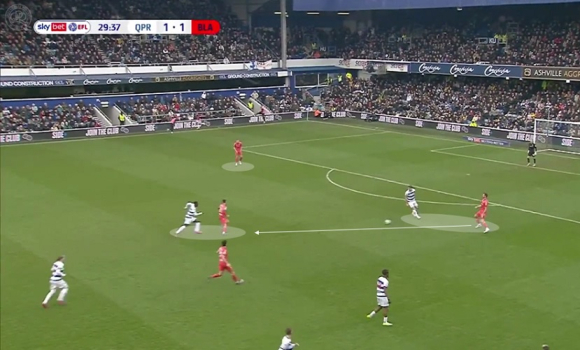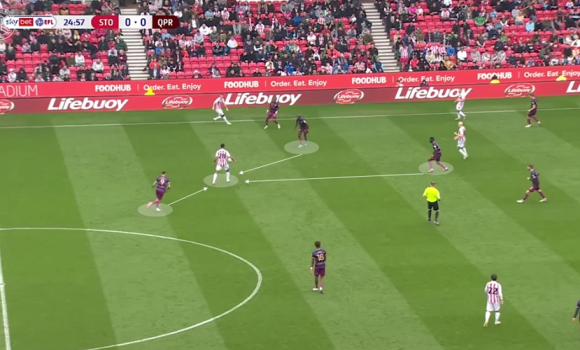Out of possession evolution under Ainsworth — Analysis Wednesday, 3rd May 2023 17:05 by Dan Lambert In his final LFW column of the season, our resident Dan Lambert looks into how Gareth Ainsworth has stemmed the bleeding, conceding and the losing, despite posting sub-20% possession stats in recent victories at Burnley and Stoke. The overriding feeling after Stoke at the weekend was relief for simply staying up. It’s been a poor season but thanks to our recent flurry of results, including back-to-back away wins, we have secured Championship status for another season. What has been obvious to me across Ainsworth’s games has been the evolution of our approach out of possession across the eight weeks he has been in charge. We’ve obviously seen the recent extreme of our 4-4-2 mid to low block where we’ve set up to sit, compress space and hit teams on the counterattack with a mere 18% possession but that has evolved over time. I’ll detail the change across games from the start at Blackburn at home all the way to Stoke away as well as dissecting the recent two results, how our out of possession approach ‘won’ us the game and where we can go from here. In the beginningAinsworth’s tenure started against Blackburn where we set up in a 4-3-3 which matched Blackburn’s 4-2-3-1 meaning we could go man-to-man - a principle that Ainsworth has used throughout his managerial career so far. On this occasion we went man to man all over but had a -1 up front where a rather immobile Chris Martin would have to press both CBs and hinder them using the spare man well. Before I highlight some examples, it’s worth bearing in mind a couple of things. Firstly, changing principles midway through a season with a week’s training is virtually impossible to do to a good standard. Secondly, this is something this side hadn’t done all season and weren’t really recruited for. Now before people say, ‘well they’re professional footballers getting paid X amount a week- of course they can do it’. Sure, they can do it, but this side lacks athleticism in a lot of areas. To play a man-for-man system you have to be an athletic side to keep up with your individual duels, particularly when we have had <50% possession which is happening more and more frequently under Ainsworth. So it would have been tough for us to do this well, unless we had a pre-season under our belts and some able bodies in.
In this video we see how our man-to-man structure gave us issues because if you lose your 1v1 duels in higher areas it leaves you in danger in the mid and final third once teams break the press early.
Separating the light from the darknessSo, Blackburn? Not great. Two games later and Watford at home comes about and we look far improved at pressing man to man. It wasn’t perfect, but a huge improvement particularly when the CBs were superb at engaging with the dropping attackers, helped by the fact we changed shape to a back three. I’ll show a good example of this below.
A home win at Watford led to euphoria and a lot of us thought that could be the turning point. It was the turning point, but for the wrong reasons: defeats to Blackpool, Birmingham, Wigan and Preston all back-to-back led to a very poor run of results with a lot of us thinking we were down and out at that point after losing at least three ‘winnable games’ with the teams in and around us. And it was soThat’s where the change came, at West Brom where Ainsworth surprised a lot of people with the formation change. He opted for a 4-4-2, Chair on the left, Adomah on the right and Jimmy Dunne was as an unorthodox RB. Bar the two set piece goals, we actually limited them to very little. West Brom only had 0.14xG from open play so it worked to an extent but as we know that’s not how football works and we only picked up a point at the Hawthorns. It should have been something we were accustomed to quickly from our experience of it under Critchley, but even at points there were teething problems, particularly with distances and the fact with this game was we were still using the man-to-man approach which led to the effect of bigger distances between the lines both laterally and vertically.
So, the West Brom game was the beginning of the 4-4-2 shape, as I said still focused on going man to man but the improvement was there through our open play performance. It was the Norwich game just three games ago where Ainsworth opted to tweak our 4-4-2 shape, going against his principles to an extent to go from a man-to-man approach to a zonal approach- focusing on staying compact, controlling the spaces centrally and forcing Norwich around them. That was what Norwich did to an extent, except the triggers weren’t on point. Jamal Lowe playing RW in the game didn’t time the triggers well enough, often ending up in the middle between pressing Norwich’s LB and not blocking off the inside channel.
Within that video, the final clip is of our 4-4-2 shape controlling Norwich’s build-up against their variation. Norwich formed an auxiliary back three, spreading our front two to push their FBs high and wide to pin. The issue with this for us was the distances and controlling the inside of our shape. As shown Chair doesn’t press correctly, jumping outside his lane early before the ball is played which opens up the half space channel for Norwich’s CB to find their player between the lines to receive on the half turn. Bone fide miracleStill problems within the press- but the performance against Norwich was better. Up next, Burnley and that was a huge improvement with our shape. Distances were far better both laterally and vertically as we crushed the space between the lines. We were able to double up on the wingers, especially Benson who has scored the exact same goal four games running, and the triggers were a lot sharper. The CBs too had very good games- with Dickie making three goal line clearances. I think this style suits a CB like Dunne particularly, forcing Burnley into crosses from deep or in the by-line when compressing spaces centrally and when the crosses do arrive a CB like Dunne is very good at winning duels aerially.
A brilliant win against Burnley- with 18% possession as well, even 13% at one point. Understandably, against Burnley you can totally understand that, but a week later we play Stoke, win and the same approach occurs. Another 18% possession performance setting up to sit off and counter Stoke. Below I’ll analyse our out of possession performance against Stoke with some key examples. It’s worth noting that the only major difference was we weren’t sitting in a complete low block like we did against Burnley; it was more of a mid block and the shape was higher in its starting point.
Stoke’s aim a lot of the time was to get their attackers, and particularly their no.10 Will Smallbone between the lines.
The main difference from the last two games in this 4-4-2 shape has been how compact we’ve been. Forcing play on the outside, a similar concept to the way we set up with Beale but slightly different because of the shape and triggers.
As well as being more compact with distances across our lines laterally we’ve also improved on our distances vertically preventing space between the lines by blocking passing lanes and being tighter with our shape.
Scoring early in the second half certainly helped us in defending our lead and being passive in the game. Stoke needed to throw things at us so they tried to play more risky passes to break our shape.
All in all, our out of possession approach on Saturday against Stoke, and Burnley the week before, was hugely improved - being hard to beat and well drilled. Going back to the start of my piece; it’s been interesting to see Ainsworth’s flexibility in adapting to the players’ needs against his principles, going from a rigid man-to-man approach to a zonal one, when other managers could easily stick to their guns. Now we’re safe everyone will be looking towards the summer. How will the style evolve, if it even will? How will we recruit with Ainsworth? Etc etc. But in terms of the theme of this piece focusing on our out of possession approach: will he stick to his principles and go back to being a man-to-man side or will he continue the work that’s been quite successful and stay with a zonal? This season hasn’t been a hugely enjoyable one and now we’ve secured our Championship status at least we’ve got the summer to look ahead/forget QPR exist for a few months before it starts all over again. Links >>> More like this at Dan’s SubStack >>> What have we learned so far? >>> QPR’s attacking set pieces >>> Struggling to break down defences >>> Positive changes v Sheff Utd >>> Ainsworth’s structural headache If you enjoy LoftforWords, please consider supporting the site through a subscription to our Patreon or tip us via our PayPal account loftforwords@yahoo.co.uk. Pictures — QPRPlusPass The Twitter @DanLambert__ Action Images Please report offensive, libellous or inappropriate posts by using the links provided.
You need to login in order to post your comments |
Blogs 31 bloggersBristol Rovers Polls |















